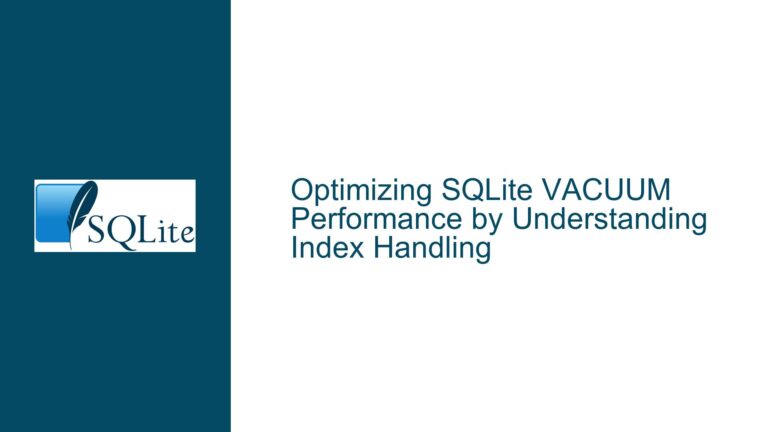Refreshing SQLite Query Planner Statistics Without Reopening Connections
Understanding ANALYZE and Connection-Specific Statistics Caching
SQLite relies on statistical metadata stored in internal tables (sqlite_stat1, sqlite_stat4, etc.) to guide the query planner in selecting optimal execution strategies. These statistics are generated via the ANALYZE command and include details such as index selectivity, row counts, and histogram data. A critical but often misunderstood aspect of SQLite’s behavior is how these statistics are cached at the connection level. When a database connection is established, SQLite reads the statistics tables once during the first query optimization and retains them in memory for the connection’s lifetime. This caching mechanism ensures efficient query planning but introduces challenges when statistics are updated while connections remain active. The core issue revolves around ensuring that all active connections use the most recent statistics without requiring termination and re-establishment.
The ANALYZE sqlite_schema command plays a pivotal role here. While ANALYZE recalculates statistics and writes them to the sqlite_stat* tables, ANALYZE sqlite_schema forces active connections to reload these statistics. However, confusion arises about when each command is necessary and how they interact with open connections. A connection executing ANALYZE automatically uses the new statistics for subsequent queries, but other connections opened before the ANALYZE will continue using stale data unless explicitly instructed to refresh. This distinction is crucial for maintaining query performance in multi-connection environments, such as web servers or applications with connection pools.
Why Active Connections Retain Outdated Statistics
The retention of outdated statistics by pre-existing connections stems from SQLite’s design to minimize overhead. When a connection parses a query, it consults the cached statistics to generate an execution plan. This cache is populated either at the first query after connection establishment or after a manual refresh. The following factors contribute to this behavior:
Lazy Loading of Statistics: SQLite defers reading the
sqlite_stat*tables until the first query optimization occurs. This reduces startup latency but means connections opened before anANALYZEwill not automatically detect changes to these tables.Connection Isolation: Each database connection operates independently, maintaining its own schema cache, including statistics. This isolation ensures transactional consistency but means statistical updates are not propagated across connections without explicit action.
Misinterpretation of
ANALYZEScope: TheANALYZEcommand updates the statistics tables on disk but does not broadcast these changes to other connections. Only the connection executingANALYZEinvalidates its local cache and reloads statistics. Other connections remain unaware of the update unless they explicitly trigger a reload.Ambiguity in Documentation: The SQLite documentation clarifies that
ANALYZE sqlite_schemarefreshes statistics but does not emphasize the connection-specific nature of this operation. Developers might assume a global refresh, leading to unexpected performance issues when queries on older connections use obsolete data.
Forcing Statistics Refresh and Validating Query Planner Behavior
To ensure all connections use up-to-date statistics, follow these steps:
Step 1: Regenerate Statistics with ANALYZE
Execute ANALYZE during a maintenance window or after significant data changes. This updates the sqlite_stat* tables. Verify the update by querying sqlite_stat1:
SELECT tbl, idx, stat FROM sqlite_stat1 WHERE tbl = 'target_table';
Compare the stat column before and after ANALYZE to confirm changes.
Step 2: Refresh Active Connections with ANALYZE sqlite_schema
For each active connection that must use the new statistics, execute:
ANALYZE sqlite_schema;
This forces the connection to reload statistics from the sqlite_stat* tables. Note that this command does not recalculate statistics; it only refreshes the cache.
Step 3: Validate Query Plan Changes
Use EXPLAIN QUERY PLAN to check if the query planner adopts new strategies. For example:
EXPLAIN QUERY PLAN SELECT * FROM target_table WHERE indexed_column = ?;
Look for changes in index usage or join order. Consistent behavior across connections confirms successful refresh.
Step 4: Automate Refresh in Connection Pools
In applications with connection pools, integrate ANALYZE sqlite_schema into connection checkout/checkin logic. For example:
# Python pseudocode
def get_connection():
conn = pool.get()
conn.execute("ANALYZE sqlite_schema;")
return conn
This ensures each borrowed connection uses the latest statistics.
Step 5: Monitor Performance Regressions
Deploy monitoring for query latency and execution plans. Tools like SQLite’s sqlite3_stmt status counters or external APM solutions can detect regressions caused by stale statistics.
Edge Cases and Anti-Patterns
- Read-Only Connections: Connections opened with
SQLITE_OPEN_READONLYcannot executeANALYZE sqlite_schema. Restart these connections instead. - Long-Running Transactions: Connections in a transaction may delay statistics reload until the transaction commits.
- Manual Edits to
sqlite_stat*: Directly modifying these tables requires a subsequentANALYZE sqlite_schemato propagate changes.
By systematically applying these steps, developers ensure that all connections leverage current statistics, avoiding suboptimal query plans and performance degradation.






